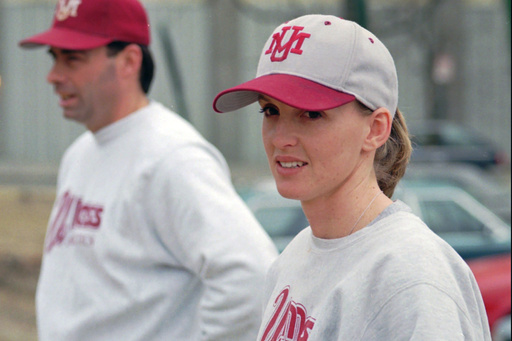
Julie Croteau’s groundbreaking journey in baseball has often found her sharing the field with male players, whether as teammates or opponents. This is a common experience for many women in the sport over the years. So, when she learned about plans for a new women’s baseball league, her reaction was simple yet jubilant: “It’s about time.”
The Women’s Professional Baseball League (WPBL) revealed a vision to launch in 2026, introducing a six-team league specifically for women. This initiative marks a significant moment in history, as it will be the first professional league for women since the All-American Girls Professional Baseball League ceased operations in 1954, a league famously portrayed in the film “A League of Their Own.”
Recognizing the increased engagement in women’s sports, co-founder Justine Siegal believes the timing is perfect for establishing a women’s baseball league. Notably, Siegal made history in 2015 as the first woman to coach a MLB team when she assisted the Oakland Athletics.
Deloitte, a consulting firm, projects that women’s sports could generate an unprecedented billion dollars in global revenue by 2024, attributed to surging popularity and lucrative marketing opportunities. The WNBA recently experienced its most-watched regular season in over two decades, buoyed by a standout rookie class including talents like Caitlin Clark and Angel Reese, while the inaugural season of the Professional Women’s Hockey League attracted substantial crowds.
Siegal acknowledges that the successes of these prior leagues have paved the way for the WPBL. She is currently gathering insights from women at the helm of other professional leagues, examining key factors that contributed to their achievements, particularly in understanding the unique challenges female athletes face, such as balancing career obligations with family duties.
Siegal recalls the early days of her career, juggled with seeking childcare for her daughter while pursuing her passion for baseball. “I had to do many things to make my dream come true,” she remarked, emphasizing her commitment to ensuring that women players with familial responsibilities are not overlooked in this new league.
Facing an uphill battle during her youth, Siegal was told by a coach at age 13 that she should switch from baseball to softball merely based on her gender—a sentiment still echoed by many girls today.
Data from the National Federation of State High School Associations reported about 1,300 high school girls competing on boys’ teams across the U.S. for the 2023-24 school year. Referring to this number, Croteau remarked, “These individuals had to essentially defy the odds to continue playing the sport they cherish.” In the 1980s, Croteau made headlines by contesting her high school’s decision to bar her from playing on the boys’ varsity team, a battle she ultimately lost.
Statistics show that while over 471,000 boys played high school baseball, approximately 473,000 girls also participated. Notably, the NCAA does not sponsor women’s baseball, yet nine women played on men’s teams during 2024, against a backdrop of about 21,000 female participants in college softball.
Co-founder Keith Stein envisions the WPBL as a way to foster a robust culture of women’s baseball in the U.S., paving the way for more opportunities for young girls as they progress in the sport. Both Stein and Siegal have noticed a positive response from female baseball players eager for a competitive environment exclusively for women. The Women’s Baseball World Cup, introduced in 2004, has also illustrated the talent and enthusiasm among women in baseball.
After the launch of the league’s player portal, over 400 athletes expressed interest in trying out within just 24 hours. “Many of these players are from the upper echelon of the sport—not just from the U.S., but also from Japan, Canada, and Great Britain,” Stein noted.
The league will conduct a scouting camp in the spring of 2025, followed by a draft towards the end of the year. As it launches, the WPBL will kick off with six teams competing in the northeast, facilitating travel via bus.
While Stein holds high hopes for the WPBL’s future, he acknowledges the league will confront challenges similar to those faced by existing women’s leagues. The demand for equal pay in sports has been a longstanding issue, illustrated by the U.S. women’s national soccer team’s struggle for fairness, which culminated in a significant equal pay bill being passed in the House in 2022.
“In reality, women baseball players are likely not capable of earning what they rightfully deserve,” stated Stein, who believes the league will provide reasonable compensation for players relocating or giving up existing jobs to join.
However, he correctly warns that these salaries will fall short in comparison to those of major league athletes in other leagues. “Our goal is to elevate the status of professional women baseball players over time,” he added. “But this will be a gradual process.”
Croteau, who isn’t directly involved with the WPBL, lauded the league for its efforts to close gaps that have existed for decades, long before she and her teammate Beanie Ketcham blazed trails as the first women in MLB-affiliated minor leagues 30 years ago. “For those girls competing on their own, the currently existing 1,300, we know they are deserving and passionate about their sport,” Croteau remarked. “This league will provide them much-needed visibility.”
